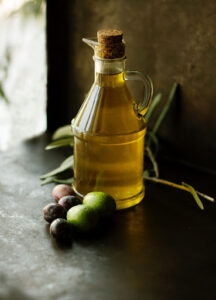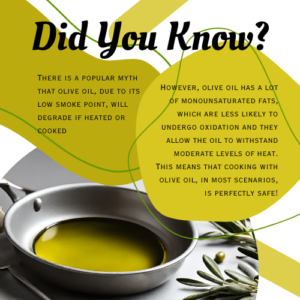Written By: Tvisha Lakhani
Edited By: Nehaa Kousihan
Designed By: Jiya Mehta
Published By: Tvisha Lakhani
 Here’s something you’ve probably heard of or seen before: olive oil. Maybe you’ve seen it at the grocery store while passing by aisles of meticulously arranged bottles. Maybe you’ve seen it in cookbooks or food websites, all praising its taste and health benefits. Or maybe you’ve just seen it lying on your kitchen counter and haven’t ever thought much of it. A clear liquid somewhere between amber to deep green, olive oil is as enjoyable to learn about as it is to consume.
Here’s something you’ve probably heard of or seen before: olive oil. Maybe you’ve seen it at the grocery store while passing by aisles of meticulously arranged bottles. Maybe you’ve seen it in cookbooks or food websites, all praising its taste and health benefits. Or maybe you’ve just seen it lying on your kitchen counter and haven’t ever thought much of it. A clear liquid somewhere between amber to deep green, olive oil is as enjoyable to learn about as it is to consume.
When most people think of olive oil, they think of its renowned health benefits. Olive oil has high levels of antioxidants and contains more than 70% monounsaturated fat. This can reduce inflammation and prevent blood cholesterol from oxidation, helping reduce a person’s risk of heart disease. Olive oil contains many minerals and vitamins, including vitamins E and K. Additionally, it’s known to have antibacterial properties and studies have shown that olive oil may be beneficial for reducing the risk of cancer and type 2 diabetes.
But it took us a long time to get to this point in the discovery and research of olive oil. Currently, Spain, Italy, Greece, and Tunisia are its main producers, but the making of olive oil is documented as far back as 2500 BCE. It was first used as oil for lamps, and was eventually introduced to the culinary world in the 5th-4th century BCE. In older times, all olive oil production was done manually. The process got easier when Romans and Greeks in the Mediterranean started to make olive press machines to replace the labour-intensive process of crushing olives by hand. Olive oil production has only increased since.
This may beg the question, how is olive oil made? At the most basic level, olive oil is just olive fruit juice. It’s made by crushing olives and separating the oil from the pulp using a centrifuge (a spinning machine that uses centrifugal force). Olive oil is often further refined using chemical solvents and heat to remove impurities.
Olive oil can be classified by taking a look at the method used to make it (along with a few other factors). Extra virgin olive oil is made using only mechanical processes like crushing and centrifuging. In order to classify as extra virgin, olive oil must have less than 0.8% acidity. This type of olive oil is commonly considered the best, most flavourful, and healthiest. A bottle of extra virgin olive oil is often more expensive than other types of olive oil too. Slightly lower on the quality scale are virgin olive oil and ordinary virgin olive oil. Both of these have higher acidities (0.8% – 2% for virgin olive oil, 2% to 3.3% for ordinary virgin olive oil) compared to extra virgin oil. Olive oil that is processed using chemical solvents and heat is called refined olive oil. This is the most processed of all types of olive oil, and is generally lesser in both flavor and price.
This classification of olive oil can change slightly depending on the country, but extra virgin olive oil is unanimously considered to be the highest quality of olive oil, and consequently the most expensive too. This often leads to companies fraudulently labeling their olive oil as ‘extra virgin’. This type of fraudulent oil is often mixed with refined olive oil (or other lower quality oils). Sometimes, it isn’t even olive oil; other types of cheaper oils are mixed in with dyes and labeled ‘olive oil’!
To avoid buying this kind of oil, it’s important to do your research across a variety of sources to find its origin. Checking the origin, along with the type of olives used and their harvest date, can be helpful to ensure you choose the oil with the taste best suited to your taste buds and needs.
So the next time you see that bottle of olive oil lying on your kitchen counter, maybe you won’t see only the bottle, but also everything that brought it there.
Works Cited
Ajmera, R. (2023, October 30). What Is Extra Virgin Olive Oil, and Why Is It Healthy? Healthline. https://www.healthline.com/nutrition/extra-virgin-olive-oil
Answer in Progress. (2021, January 14). we committed olive oil fraud [Video]. YouTube. https://www.youtube.com/watch?v=9oK6MBYGpb8
Editors of Encyclopaedia Britannica. (2023, November 2). Olive oil. Britannica. https://www.britannica.com/topic/olive-oil
Hirst, K. (2019, May 24). The Ancient History of Making Olive Oil. ThoughtCo. https://www.thoughtco.com/ancient-history-of-making-olive-oil-4047748
Karadsheh, S. (2022, January). Olive Oil 101: Everything You Need To Know. The Mediterranean Dish. https://www.themediterraneandish.com/olive-oil-guide/
Karadsheh, S. (2022, March 3). Cooking with Olive Oil: Everything You Need To Know! The Mediterranean Dish. https://www.themediterraneandish.com/cooking-with-olive-oil/
Leech, J. (2023, February 3). 11 Proven Benefits of Olive Oil. Healthline. https://www.healthline.com/nutrition/11-proven-benefits-of-olive-oil
McGee, H. (2004). On Food and Cooking: The Science and Lore of the Kitchen (Revised and Updated 2nd Edition). Simon & Schuster. (Original work published 1984)
Olive Wellness Institute. (n.d.). Cooking with Olive Oil. https://olivewellnessinstitute.org/extra-virgin-olive-oil/cooking-with-olive-oil/
Sorge, R. (2016). Clear glass cruet bottle olive oil [Photograph]. Unsplash. https://unsplash.com/photos/clear-glass-cruet-bottle-uOBApnN_K7w

